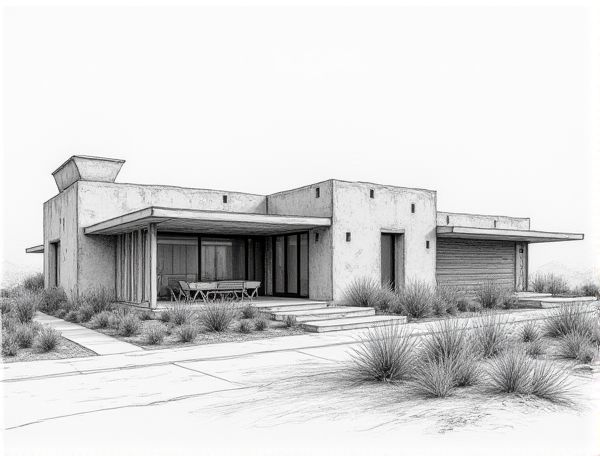
Photo illustration: Desert modernism home design with rammed earth wall construction
Desert modernism home design uniquely blends sleek, minimalist aesthetics with the rugged beauty of natural materials like rammed earth walls, offering exceptional thermal mass and energy efficiency to harmonize with arid landscapes. Explore how incorporating rammed earth walls can transform Your living space with sustainable, durable elegance by reading more in the article.
Introduction to Desert Modernism in Home Design
Desert Modernism in home design emphasizes clean lines, natural materials, and seamless integration with arid landscapes to create a harmonious living environment. This style incorporates expansive glass walls, flat roofs, and earthy tones that reflect the desert's beauty, enhancing energy efficiency and indoor-outdoor connectivity. Your home can benefit from Desert Modernism's minimalist aesthetic and sustainable features, tailored to complement the unique climate and terrain of desert regions.
Key Principles of Desert Modernism Architecture
Desert Modernism architecture emphasizes clean lines, open floor plans, and large glass windows to seamlessly blend indoor and outdoor living spaces while maximizing natural light. This design prioritizes sustainable materials and energy-efficient features to withstand harsh desert climates, such as heat-resistant roofing and strategic shading. You can create a tranquil, functional home by integrating native landscaping and minimalist aesthetics that reflect the surrounding desert environment.
Sustainability and Energy Efficiency in Desert Homes
Utilizing high-performance insulation, solar panels, and passive cooling techniques significantly enhances sustainability and energy efficiency in desert homes. Incorporating materials with high thermal mass and strategically positioning windows for natural ventilation reduces reliance on artificial cooling, cutting energy consumption and minimizing environmental impact.
Benefits of Rammed Earth Wall Construction
Rammed earth wall construction offers exceptional thermal mass, helping to regulate indoor temperatures and reduce energy costs in your home. These walls provide superior durability and fire resistance, ensuring long-lasting protection and safety. Utilizing natural and locally sourced materials, rammed earth construction supports sustainable building practices and minimizes environmental impact.
Integrating Rammed Earth with Modern Design Elements
Rammed earth walls provide natural insulation and thermal mass, enhancing energy efficiency in modern homes while creating a distinctive aesthetic. Your design can incorporate sleek metal or glass features to complement the earthy texture and muted tones of rammed earth, achieving a balanced fusion of rustic and contemporary styles. Innovative lighting and minimalist furnishings further highlight the structural beauty and sustainable benefits of this eco-friendly building material.
Climate Responsiveness: Rammed Earth in Arid Environments
Rammed earth construction excels in arid environments due to its thermal mass, which stabilizes indoor temperatures by absorbing heat during the day and releasing it at night. This natural insulation reduces reliance on mechanical cooling, enhancing energy efficiency while maintaining comfort. The breathable walls also regulate humidity, creating a healthier indoor climate suited for dry, hot regions.
Interior Aesthetics of Rammed Earth Desert Homes
Rammed earth walls create a unique interior aesthetic by offering natural texture and earthy tones that blend seamlessly with desert surroundings. Your home benefits from sustainable insulation properties, maintaining comfortable temperatures and reducing energy costs. Incorporating minimalist furniture and desert-inspired decor enhances the warm, organic ambiance inherent to rammed earth design.
Eco-Friendly Materials and Sustainable Sourcing
Eco-friendly materials such as bamboo flooring, reclaimed wood, and recycled metal significantly reduce environmental impact while maintaining durability and aesthetic appeal in home design. Sustainable sourcing prioritizes local suppliers and certifications like FSC and Cradle to Cradle, ensuring that resources are harvested responsibly and support long-term ecological balance.
Case Studies: Iconic Desert Modernism Rammed Earth Homes
Explore how iconic Desert Modernism Rammed Earth homes maximize thermal efficiency and sustainable design through innovative material use and integration with natural surroundings. Your home can benefit from case studies demonstrating passive cooling techniques and durable, eco-friendly construction.
Future Trends in Desert Modernism and Rammed Earth Construction
Future trends in desert modernism emphasize sustainable rammed earth construction techniques that enhance thermal mass and natural insulation, promoting eco-friendly and energy-efficient homes in arid climates. Innovations in material additives and digital modeling optimize structural durability and aesthetic integration, ushering in a new era of resilient, minimalist desert architecture.
 homedesy.com
homedesy.com